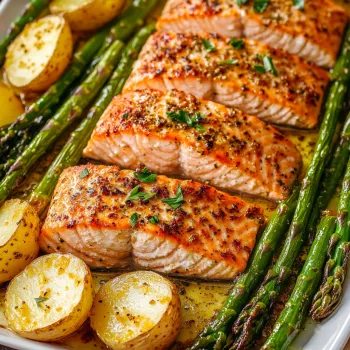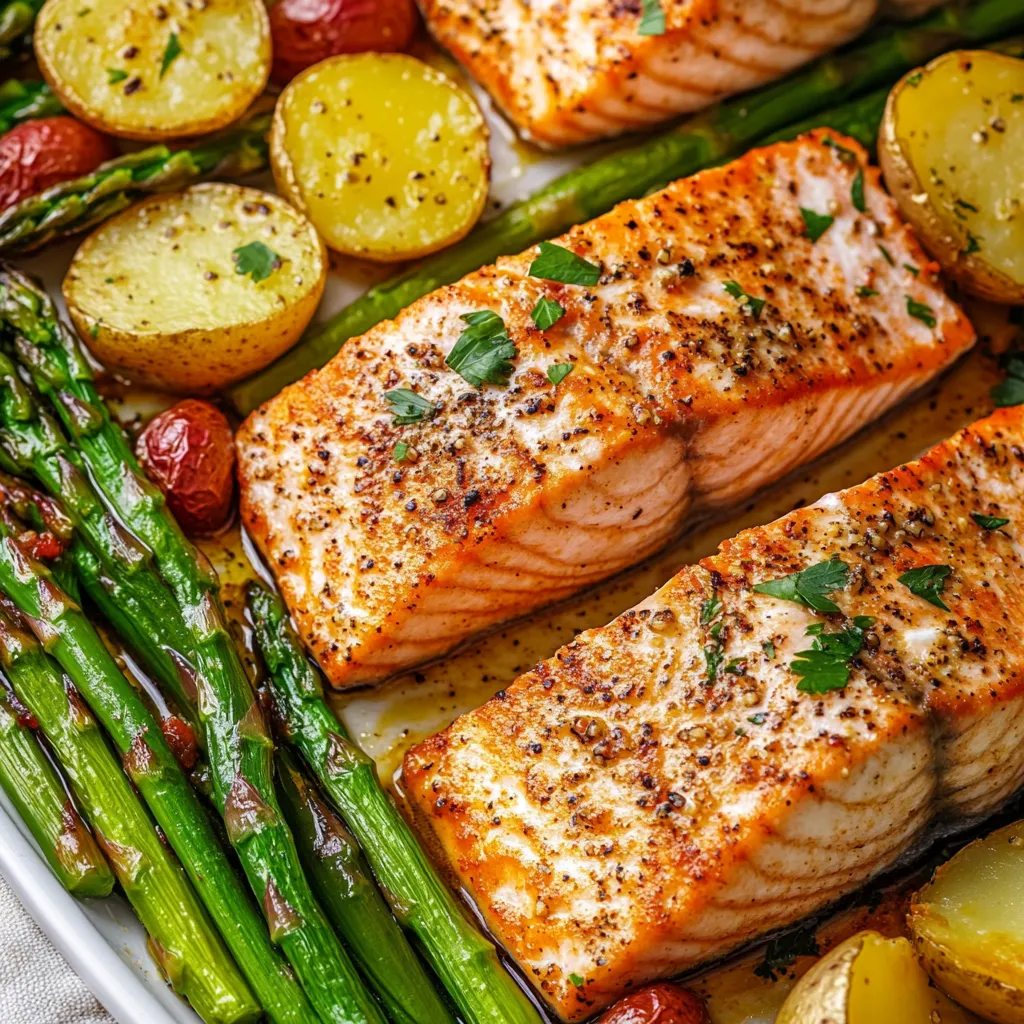 Pin it
Pin it
I stumbled on this method during an incredibly hectic time in my life, and now it's what I turn to when I want something fancy but can't spend forever in the kitchen. The way the sweet-tangy glaze browns on the salmon always gets compliments from guests.
Key Ingredients and Shopping Advice
- Salmon Fillets: Try to grab pieces with similar thickness so they cook evenly. Wild salmon tastes amazing, but farmed works just fine too.
- Baby Potatoes: Get ones that are roughly the same size for consistent cooking. The red or yellow kinds keep their shape really well.
- Fresh Asparagus: Look for bright green stalks with compact tips. Go for the thicker spears as they stand up better to this cooking method.
- Dijon Mustard: The grainy or smooth kind works great. Don't swap in yellow mustard as it's way too sharp.
- Quality Butter: Grab unsalted so you can control how salty your glaze turns out.
- Fresh Lemon: Pick ones that feel heavy and bright for the most juice and flavor.
Perfect Timing Steps
- Step 1: Give Those Potatoes a Head Start
- Slice potatoes into same-sized chunks for even cooking. Mix them really well with oil and seasonings so each piece gets coated. Lay them out with space between each piece. Let them get a 10-minute jumpstart in the oven.
- Step 2: Mix Up That Amazing Glaze
- Melt your butter gently so it doesn't break. Stir the honey and mustard until they're totally combined. Add your herbs at the end to keep their flavor fresh. Keep the mixture warm until you need it.
 Pin it
Pin it
After making this countless times, I've learned that how you arrange everything on the pan really matters. Putting salmon in the middle with veggies around the edges lets heat move around properly. My mom always told me, 'Give your food room to breathe on the pan,' and she couldn't have been more right.
Understanding Your Pan's Hot Spots
I've noticed that different parts of a sheet pan don't heat the same way. The edges tend to run hotter, making them great for getting those potatoes super crispy, while the middle area provides gentler heat that's perfect for salmon. Knowing these differences helps everything turn out just right.
Getting That Perfect Glaze
That honey-mustard mixture isn't just a topping, it's what makes this dish so special. I've found that brushing it on twice, once before cooking and again halfway through, gives you that beautiful caramelized finish without any burnt spots.
Rounding Out Your Meal
Though this dish stands on its own perfectly well, I sometimes add quick sides to make it even better. A basic green salad with lemon dressing or some warm crusty bread makes dinner feel extra special without adding any hassle.
 Pin it
Pin it
This one-pan Salmon and Asparagus has become more than just another dinner option in my kitchen, it's my trusted go-to when I want something impressive without the hassle. Whether you're feeding your family or having friends over, this dish delivers restaurant-quality food with minimal work. The mix of perfectly cooked salmon, crispy potatoes, and tender asparagus makes a complete meal that's both satisfying and a bit fancy. Just remember, great sheet pan dinners come down to timing and temperature. Pay attention to how your specific oven behaves, make small adjustments as needed, and you'll end up with a perfectly coordinated dinner every single time.
Frequently Asked Questions
- → Can I cook this with frozen salmon?
- Yes, just let it fully thaw and dry it well before cooking so it roasts properly.
- → How can I tell if the salmon's ready?
- It should be tender and flake easily with a fork, with a slightly pink center. Typically takes about 15 minutes.
- → Is this good for meal prep?
- Absolutely! Store it in the fridge for up to 3 days, and reheat in the oven for the best texture.
- → What can I use instead of asparagus?
- You can swap it for green beans, broccoli, or Brussels sprouts. Adjust the cooking time based on the veggie you choose.
- → Why cut potatoes small?
- Smaller potato pieces cook faster and turn crispy outside while staying soft inside, syncing well with the salmon.
